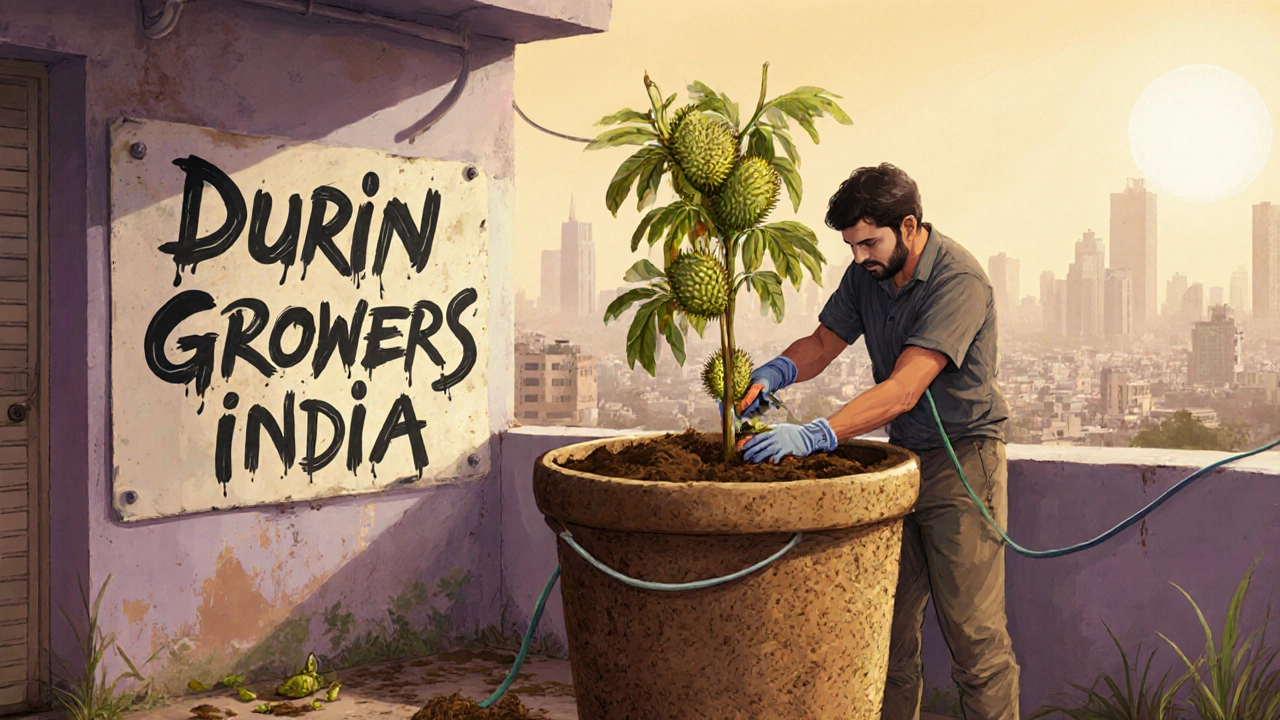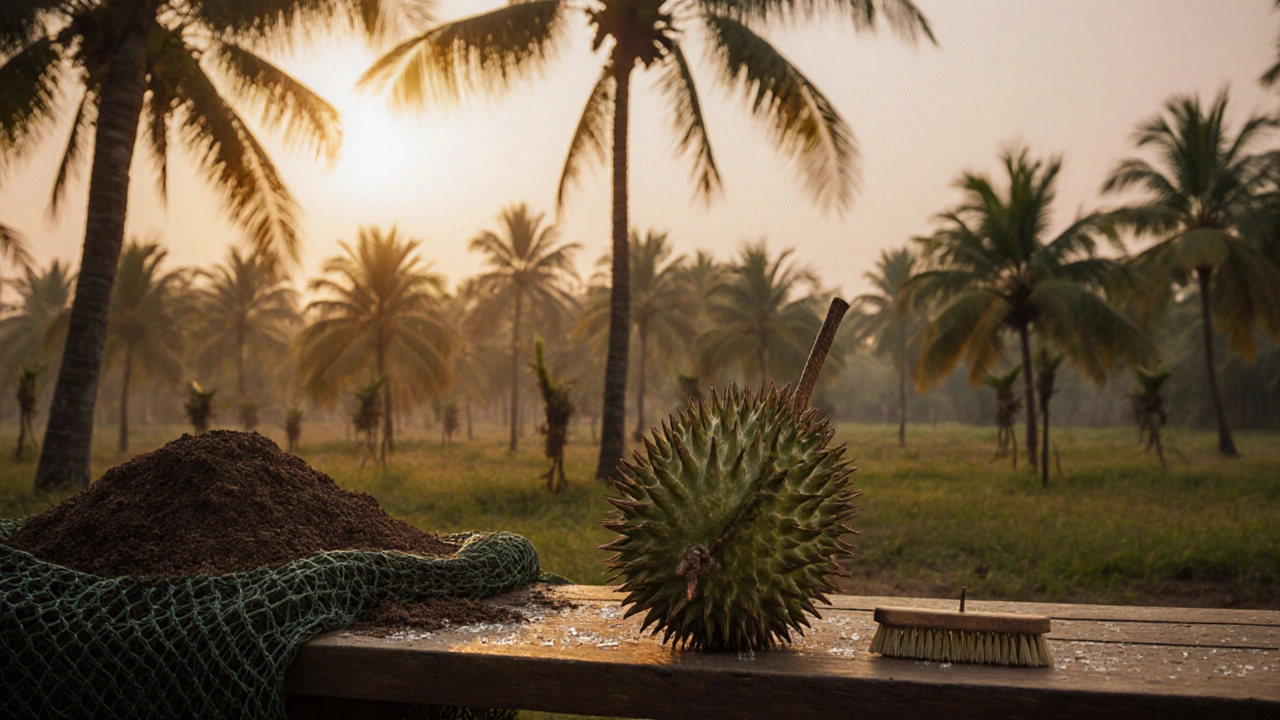Durian Profit Calculator
Calculate your potential profit from growing durian trees in India based on your specific conditions.
Results
Estimated Yield
0 kg
Total Revenue
₹0
Costs
₹0
Net Profit
₹0
Note: These estimates are based on average market conditions. Actual results may vary based on local market fluctuations and farming practices.
When you think of expensive fruits, you might picture imported kiwis or rare berries from Europe. But in India, the most costly fruit doesn’t come from overseas-it grows right here, often in the backyards of farmers who know exactly how to coax it into perfection. The answer? Durian.
Yes, durian. That spiky, pungent fruit that smells like gym socks and sweet cream mixed together. It’s not just expensive-it’s worth more per kilo than gold in some parts of India. And if you’re into vegetable gardening in India, you’ve probably seen it pop up in local markets or heard whispers about it from farmers who swear by its value.
Why Durian Costs So Much in India
Durian isn’t native to India. It’s from Southeast Asia-Thailand, Malaysia, Indonesia. But over the last decade, it’s found a surprising foothold in southern India, especially in Kerala, Tamil Nadu, and parts of Karnataka. Why? Because the climate there mimics its natural habitat: hot, humid, and wet.
But here’s the catch: durian trees take 5 to 7 years to bear fruit. That’s a long time to wait without income. Farmers who grow it don’t just plant it-they treat it like a luxury crop. They use organic compost, hand-pollinate the flowers, and protect each fruit with mesh nets to keep pests and birds away. A single durian tree can produce 50 to 100 fruits per year, but only 10 to 20 make it to market in perfect condition.
At wholesale, durian sells for ₹800 to ₹1,500 per kg in India. In high-end supermarkets in Bangalore or Mumbai, it can hit ₹2,000 or more. Compare that to mangoes, which sell for ₹80-₹150 per kg during peak season. That’s a 10x markup. And when demand spikes around festivals like Diwali or Christmas, prices jump again.
What Makes Durian So Desirable
It’s not just the price tag. People pay for the experience. The flesh is creamy, custard-like, with a flavor that’s sweet, buttery, and slightly oniony. It’s polarizing-you either love it or can’t stand it. But for those who do, it’s a status symbol. Giving someone a durian as a gift says, “I spent a lot on this for you.”
It’s also rich in nutrients. One cup of durian has 357 calories, 13 grams of fat, 66 grams of carbs, and 9 grams of fiber. It’s packed with vitamin C, potassium, and B vitamins. In traditional medicine, it’s used to boost energy and improve digestion. That’s why health-conscious urban buyers are willing to pay more-even if they’ve never tasted it before.
How It’s Changing Indian Gardening
If you’re into vegetable gardening in India, you might think durian doesn’t belong. After all, it’s a fruit tree, not a tomato or spinach. But here’s the shift: urban farmers and terrace gardeners are starting to experiment with it. Not because they want to grow a whole orchard, but because they want to try something new, profitable, and different.
Small-scale growers in Bengaluru and Coimbatore are planting durian in large pots-50-gallon containers filled with loamy soil, coconut coir, and cow dung compost. They use drip irrigation to keep moisture steady and shade nets to protect young trees from scorching sun. Some even use root stimulants and mycorrhizal fungi to speed up early growth.
One farmer in Palakkad, Kerala, told a local newspaper he turned his 200-square-meter backyard into a durian nursery. He sold 14 saplings last year at ₹3,500 each. That’s ₹49,000 from one season’s worth of plants. He didn’t even wait for fruit-he made money on the trees themselves.

Challenges for Home Gardeners
Don’t be fooled by the hype. Growing durian at home isn’t easy. Here’s what you’re up against:
- Space: A mature durian tree can grow over 30 meters tall. Even dwarf varieties need at least 6x6 meters of open ground.
- Climate: It needs year-round temperatures above 24°C. If your area drops below 18°C for more than a few days, the tree won’t survive.
- Pollination: Durian flowers bloom at night and need bats or moths to pollinate them. In cities, you’ll need to hand-pollinate using a small brush.
- Smell: The fruit’s odor is so strong that many apartment complexes ban it. You can’t just leave one on your balcony.
That’s why most successful home growers start with grafted saplings-cuttings from proven high-yield trees. Buying a seedling from a random nursery? You might wait 10 years and get a sour, fibrous fruit. Grafted trees from certified nurseries in Tamil Nadu or Andhra Pradesh give you fruit in 4 to 5 years with predictable quality.
Other Expensive Fruits in India (And Why They’re Not #1)
Durian isn’t the only pricey fruit in India. Here are a few others-and why they don’t top the list:
- Alphonso Mangoes: These are India’s most famous mangoes, selling for ₹400-₹800 per kg. But they’re seasonal, and thousands of farmers grow them. Supply keeps prices down.
- Japanese Yubari King Melons: Imported from Japan, these sell for ₹15,000-₹25,000 per melon. But they’re not grown in India. They’re luxury imports.
- Red Dragon Fruit: Grown in Maharashtra and Andhra, it costs ₹250-₹400 per kg. It’s trendy, but easy to grow and doesn’t need special care.
- Black Sapote: Also called chocolate pudding fruit, it’s rare in India. Costs ₹600-₹1,000 per kg. But it’s not widely known or demanded.
Durian wins because it’s locally grown, hard to produce, and has a cult following. No other fruit in India combines scarcity, local cultivation, and high demand like it does.

Should You Grow It?
If you’re a backyard gardener with space, patience, and a warm climate, yes-give it a shot. But don’t expect quick returns. Think long-term. Plant one tree. Learn how it behaves. Talk to other growers in your region. Join online groups like “Durian Growers India” on Facebook. Ask about soil pH, watering schedules, and which varieties thrive in your area.
Some popular varieties to look for:
- Musang King: The most sought-after. Rich, creamy, less odor. Best for export.
- Monthong: Milder taste, easier to sell locally.
- Chanee: More tolerant of cooler temps. Good for northern Karnataka.
Start with a grafted sapling from a reputable nursery. Don’t buy seeds. Don’t rush. Water daily for the first year. Mulch heavily. Protect from wind. And when the first fruit finally appears? You’ll know why people call it the king of fruits.
Where to Buy Durian Saplings in India
You won’t find durian saplings at your local nursery. But here are trusted sources:
- GreenKart (Kerala): Offers Musang King and Monthong grafts. Ships across India.
- Tamil Nadu Agricultural University (TNAU): Provides certified saplings for farmers.
- AgriBazaar (Online): Connects buyers with verified nurseries in Andhra and Karnataka.
Expect to pay ₹2,500-₹4,500 per sapling. That’s a big investment-but if you grow one healthy tree, it can pay for itself in 2 to 3 harvests.
Is durian really the costliest fruit grown in India?
Yes, among fruits actually grown in India, durian is the most expensive. While imported fruits like Japanese Yubari melons cost more, they aren’t cultivated here. Durian is grown locally in southern states and commands the highest price per kilogram due to its rarity, long growth cycle, and high demand.
Can I grow durian in my balcony garden?
You can grow a young durian tree in a large container (50+ gallons), but it won’t thrive long-term. Mature trees need deep soil, space to spread roots, and full sun. Balconies often lack these. If you try, use dwarf rootstock, provide full-day sunlight, and be ready to transplant it to ground level after 2-3 years.
Why does durian smell so bad?
Durian contains sulfur compounds similar to those in rotten eggs or onions. These compounds-like ethyl 2-methylbutyrate and hydrogen sulfide-are what give it its strong odor. But the smell fades quickly once the fruit is opened and eaten. Many people say the taste makes up for the smell.
How long does it take for a durian tree to bear fruit?
From seed, it takes 7-10 years. From a grafted sapling, it takes 4-6 years. Most commercial growers use grafts because they guarantee fruit quality and reduce waiting time. Patience is key.
Is durian farming profitable for small farmers in India?
Yes, if done right. A single mature tree can produce 60-80 fruits per year. At ₹1,500 per fruit (average wholesale), that’s ₹90,000-₹120,000 per tree annually. After accounting for labor and inputs, net profit can be ₹60,000-₹80,000 per tree per year. That’s higher than most cash crops.
If you’re serious about growing durian, start small. Learn from others. Track your progress. And when you finally taste that first homegrown fruit? You’ll understand why it’s worth every drop of sweat-and every rupee.

